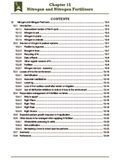Fert$mart Chapter 3 - Plant nutrient requirements
29 June 2021
-
Fert$mart Chapter 3 - Plant nutrient requirementsPDF, 1.05 MB
Plants require nutrients for normal growth. These must be in a form useable by the plants and in concentrations that allow optimum plant growth. Furthermore, the concentrations of the various soluble soil nutrients must be properly balanced.
This chapter forms part of the Dairy Soils and Fertiliser manual. Find out more at Fert$mart.



